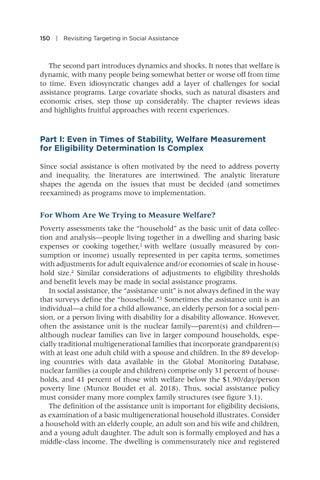150 | Revisiting Targeting in Social Assistance
The second part introduces dynamics and shocks. It notes that welfare is dynamic, with many people being somewhat better or worse off from time to time. Even idiosyncratic changes add a layer of challenges for social assistance programs. Large covariate shocks, such as natural disasters and economic crises, step those up considerably. The chapter reviews ideas and highlights fruitful approaches with recent experiences.
Part I: Even in Times of Stability, Welfare Measurement for Eligibility Determination Is Complex Since social assistance is often motivated by the need to address poverty and inequality, the literatures are intertwined. The analytic literature shapes the agenda on the issues that must be decided (and sometimes reexamined) as programs move to implementation.
For Whom Are We Trying to Measure Welfare? Poverty assessments take the “household” as the basic unit of data collection and analysis—people living together in a dwelling and sharing basic expenses or cooking together,1 with welfare (usually measured by consumption or income) usually represented in per capita terms, sometimes with adjustments for adult equivalence and/or economies of scale in household size.2 Similar considerations of adjustments to eligibility thresholds and benefit levels may be made in social assistance programs. In social assistance, the “assistance unit” is not always defined in the way that surveys define the “household.”3 Sometimes the assistance unit is an individual—a child for a child allowance, an elderly person for a social pension, or a person living with disability for a disability allowance. However, often the assistance unit is the nuclear family—parent(s) and children— although nuclear families can live in larger compound households, especially traditional multigenerational families that incorporate grandparent(s) with at least one adult child with a spouse and children. In the 89 developing countries with data available in the Global Monitoring Database, nuclear families (a couple and children) comprise only 31 percent of households, and 41 percent of those with welfare below the $1.90/day/person poverty line (Munoz Boudet et al. 2018). Thus, social assistance policy must consider many more complex family structures (see figure 3.1). The definition of the assistance unit is important for eligibility decisions, as examination of a basic multigenerational household illustrates. Consider a household with an elderly couple, an adult son and his wife and children, and a young adult daughter. The adult son is formally employed and has a middle-class income. The dwelling is commensurately nice and registered


